#Geological Modeling
Explore tagged Tumblr posts
Text

Best Software for 3D Geological Modelling Infographic Discover Geomage's seismic processing software designed for efficient, high-resolution subsurface imaging. Ideal for exploration and development, with advanced algorithms and user-friendly workflows trusted by geophysicists globally.
#seismic imaging#geology software#geological modeling#Seismic Data Processing Companies#Seismic Analysis Software#seismic interpretation software
0 notes
Text
i just learnt that the continents that you learn in school depend on the country, and that some countries teach in schools that there are 7 continents and other teach that there are 6, but there are also models that only count 5 or even 4 continents
#i just thought i wasn't up to date with our geological research#cause i was taught that america is just one big continent#(and then there's europe asia africa australia and antarctica)#and i when i saw people saying that north america and south america are two different continents i was confused#turns out that's the model used in english-speaking countries#and that romance-speaking countries usually consider america one big continent#so that's interesting#one new thing i've learnt i guess!!
4 notes
·
View notes
Text
How Drones Revolutionize Geological Exploration
Geological exploration has come a long way, from manual surveying and laborious data collection to the adoption of cutting-edge technologies. One such groundbreaking innovation is the use of drones in geological exploration. Drones, also known as unmanned aerial vehicles (UAVs), have rapidly transformed the field of geology, revolutionizing the way data is gathered, analyzed, and interpreted. In this article, we will delve into the various applications and benefits of drones in geological exploration and uncover how they have reshaped the industry.
0 notes
Text
youtube
This video showcases my Blender model of the planet that the Scud aliens call home, the fourth and final world I've mapped out for @jayrockin's "Runaway to the Stars" project. A *lot* of maps were created in service of this final render, and also in service of presenting the special qualities of this planet. I intend to show you as many of these as I can under the cut, and also in subsequent posts focusing on some of the more interstitial, ancillary maps and figures that played a part in producing the primary maps you'll see in this main post.
Before I show the first maps I made for this project, what you see below are the satellite-style maps for the Equinoxes and Solstices, in order of (Northern) Spring, Summer, Fall, and Winter, the latter serving as the texture for the Blender object you saw in the video.




__________
With that matter covered, our next focus is this project's foundation: Geology. While I didn't spin as elaborate a tectonic history for this planet as I did for the Ayrum commission, I did work out as much detail as I could for the more recent geological activity, to set the stage for the elevation data - including a narrower focus on the coastal shallows that host the Scud populations.




__________
Once I could move on to climate, my first step was finding this planet's relative Insolation, which I managed thanks to @reversedumbrella's code and coaching. With an obliquity of only 16 degrees, this planet's yearly maximum Insolation levels stick close to the equator, compared to pole-to-pole oscillation we see on Earth

__________
Having a rough sense of where heat would concentrate seasonally and how the landmasses would deflect water in light of the planet's retrograde spin, I was able to set down the bi-annual ocean currents (Northern Summer above and Northern Winter below), then the monthly water temperatures pushed around by said currents, and finally -after factoring in many other considerations- the monthly land temperatures as well (combined in the second gif)


__________
Next came the seasonal air pressure maps and subsequent wind patterns (my first time creating those from scratch), which later factored into the precipitation maps. The incredible temperatures at the largest continent's interior make a desert of most of it, and the other interiors are fairly dry too, but all that heat on the equatorial ocean generates a *lot* of evaporation which ends up coming down elsewhere.




__________
With temperatures and precipitation mapped out for each month, I was able to find how the accumulation and melt of ice and snow played out, too. Given such a hot equator it's surprising to see freezing temperatures hold out in some places, but low obliquity and high elevation shield what areas they can, it seems.


__________
All this monthly data was then painstakingly combined and compared and plugged into equations to produce maps of discrete climate zones, using both the Köppen (left) and Trewartha (right) classification systems. The higher latitudes see some overlap with Earth's conditions, but the Tropics...


__________
I never really finished the map I wanted to make with my own loosely customized classification system, but I *did* get as far as this breakdown of the areas that sometimes surpass 56.7 degrees Celsius, Earth's record for highest surface temperature ever directly measured. And as you can see, that earthly record is broken by a *significant* fraction of this planet's surface, and far exceeded by the equatorial continent's deep interior

__________
The final phase of this project dealt with creating satellite maps of this planet's surface (which you saw at the top of this post), which started with a map of dry and submerged substrate, then a density map of the vegetation that sits atop it, then the colors of that vegetation under annual average conditions (demonstrating how they would appear in-person, rather than the area's appearance from orbit), and finally plant colors under seasonal conditions (same conceit as previous). In concert with the seasonal ice and snow maps, it was the four maps in the last sequence which were overlaid on the Substrate map, using the plant density map as raster masks, to produce the final Satellite-Style maps.
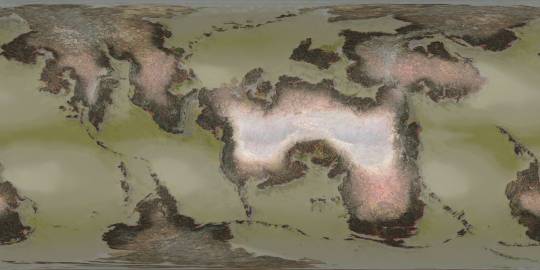



__________
This planet's sophonts being a marine species, it was then worth focusing on the conditions underwater, which included monthly seafloor temperatures (first gif), annual discharge of sediment from rivers (magenta in the 2nd gif), and seasonal upwelling of nutrients from deeper water (blue in the 2nd gif).


The creation of all my maps seen in this post was possible thanks to Photopea, which has been my go-to for several years now. The resolution kinda got crunched when I uploaded these here, so when I share them on Reddit later I'll add those links under this. These have also already been posted on Twitter, which you can see here if you like. Thanks for scrolling all the way down here!
#digital painting#Photopea#digital 3d#Blender#mapmaking#imaginary maps#Runaway to the Stars#Rtts Scuds#speculative planetology#speculative geology#speculative climatology#alien planet#major post#commission#christopher maida artwork#Youtube
770 notes
·
View notes
Text
What is a Rock?
Hey folks!
Before we get started with sharing our full survey notes, we thought it would be a good idea to go over some basic terminology to ensure we're all on the same page!
What is a Rock?
No, seriously! What counts as a “rock”? Geologically speaking, a rock is a solid, naturally-occurring collection of minerals. It might be made of a single mineral type, or multiple, but it is an aggregate of many individual mineral crystals that are interlocked together.

Fig. 1: An image of a coarse-grained granite showing individual crystals of feldspar, mica and quartz. Note that the entire rock is made up of these interlocking crystals.
What is a Mineral?
Okay, so we know what a rock is now - it's made up of minerals. But, what is a mineral? A mineral is a building component of rocks, and they have a very specific definition based on particular criteria that must be met. For something to be considered a mineral, it must meet all the following criteria:-
It must be solid
It must be naturally-occurring
It must be inorganic
It must have a definite and known chemical composition
It must have a defined crystal structure
What does this actually mean? Let’s walk through it. Criterion one discounts anything that is a liquid - such as water. As you know, rocks and minerals can become liquid when exposed to high temperatures, magma and lava for example, but in this form, they are not minerals, and therefore not rocks! They can only be classed as minerals once they solidify, provided they meet the other criteria alongside.

Fig. 2: Image of lava (a non-mineral due to its liquid form) and basalt (a fine grained, igneous rock, and the solidified form of many low viscosity lava flows).
As for the other criteria, naturally-occurring and inorganic are self-explanatory. No crystals that can only be manufactured in a laboratory setting are true minerals, because they cannot exist in nature! Crystals that are commonly lab-grown but can exist in nature (such as moissanite) still count as minerals. Inorganic means the mineral can be formed by inorganic processes. Something like calcite can be produced by animals (such as clam shells) but can also be formed by geological processes without the involvement of any living thing. This actually discounts amber as a mineral - since it is tree resin (formed organically) and is not replaced by any other minerals as is the case with fossilisation - therefore amber is not a mineral!
Having a definite chemical composition is also pretty much what it sounds like - it needs to have a chemical formula - a sequence of elements organized to form a compound that we know the definite composition of. For example, the chemical composition of quartz is SiO₂, which means it is a compound made up of atoms of silica and oxygen. Similarly, the composition of potassium feldspar - KAlSi₃O₈ is made up of potassium, aluminium, silica and oxygen atoms. When dealing with specific types of rocks, such as fine grained igneous specimens, the fine grain size of the individual crystals often makes it impractical to determine rock type via crystal analysis alone, so some geologists will use chemical analysis to aid in this - hence why it's important to know the definite chemical composition of your specimens!
Lastly, a mineral must have a crystal structure - but what is a crystal structure? The simplest way to imagine this is with building blocks. Each block is the unit that defines the chemical composition - for example, SiO₄ for quartz. So, one “block” of quartz will be a unit of SiO₄. By arranging these blocks in a repeating pattern, a larger structure begins to take form. Crystals are naturally orderly structures - imagine the blocks are piled nicely on top of each other, this is why many crystals have such well defined shapes!

Fig. 3: Diagram showing the atomic "building block" structure of quartz using a 3D model and ball-and-stick diagram; diagram showing "building blocks" arranged in the natural crystal structure; image of a quartz crystal - note the same crystal structure!
Something like glass, or a naturally-occurring glass, like obsidian, has these blocks arranged randomly, like if you were to take your tower and throw it into a storage bin. Because obsidian lacks this order on an atomic level, it isn’t considered a true mineral!

Fig. 4: Image showing a fragment of obsidian. Note the conchoidal fracturing on the obsidian - this is caused by the lack of organisation in its structure. The disorganised nature of natural glass and obsidian exclude them from being a true crystal, and therefore they are also not considered true minerals.
Unfortunately, we aren’t going to be able to run any chemical analyses in Outer Wilds, but we’ll do our best to compare what we see to real-world rocks, minerals, and features, and hopefully this will be able to steer us in the correct direction regarding some of these criteria to ensure we are making the most scientifically informed analyses possible!
What is a Fossil?
Now, we just said that minerals and rocks can’t be organic, and you’re probably thinking, well hold on a second, what about fossils? How can something that was organic become inorganic, and then a rock?
Let’s start by defining what a fossil actually is. Fossils are described as “any preserved remains, or trace of a once-living thing from a past geological age.” This includes anything from the fossilised skeletons of dinosaurs, to the delicate imprints of leaves and plants. Now, it’s important to note that not all fossils are rocks. Objects preserved in amber, for example, are classed as fossils - but as they remain organic they cannot be classed as a rock.
How do we go from something organic, like a bone, to an inorganic version of it? Probably the most well known form of fossilisation is via replacement - where organic remains are replaced by inorganic minerals. Most bones are made up of calcium phosphate and other organic materials. When an animal dies and is buried by sediment, these organic materials are replaced by inorganic crystals in a process known as permineralisation. Permineralisation occurs when the pores of the original specimen are infilled with mineral matter from the ground or water - which then, bit by bit, replace the original organics with minerals, eventually completely replacing the whole specimen! When this occurs, you no longer have your original animal bone, but instead a replica of it with a completely inorganic composition - a fossil! The minerals involved in replacement can vary widely, which can produce spectacular finds such as these pyritised ammonites, or opalised vertebrae!

Fig. 5: Fossilised remains of two opalised Iguanodon vertebrae; a pyritised Ammonite.
Other fossils, such as footprints and burrows provide a record of an organism’s life, as opposed to actual remains of the organism itself. These fossils are known as trace fossils and are normally impressions that have been made in soft mud/soil that has then lithified. The cool thing about trace fossils, and especially footprints, is that you’re left with a cast of whatever part of the creature made contact with the substrate - sometimes with incredible detail of footpads, claws, and/or skin. Other trace fossils include things like coprolites, gizzard stones, and nests! A trace fossil is also completely inorganic, as it’s simply an imprint of a creature, or something a creature left behind, and as such, technically classes as a rock!

Fig. 6: Photograph showing a dinosaur footprint mould and a dinosaur footprint cast. Both of these are trace fossils and have been formed via sediment infilling and lithification.
Alright, there was a lot of information there, but hopefully it has provided you with a strong foundation and understanding of what classes as a true rock! In our next post, we will be diving into the different rock types and the funky structures and features that they can create!
Hopefully, you’ll soon be able to start identifying a variety of rocks in your own Outer Wilds adventures!
If you have any questions regarding what we have talked about here, or indeed just about the Outer Wilds Geological Survey in general, please don't hesitate to drop us an ask!
Catch you in the next loop! The OWGS Team
71 notes
·
View notes
Text

George Kroustallis and Alvaro Polo
Cave House in Milos, 2023
The project is a natural extension of the island's unique topography digitally conceived using advanced 3D modeling software, incorporating real-world geological data from Milos to ensure an authentic connection with the landscape. via Designboom
#interior#interior architecture#interior design#design#designboom#contemporary architecture#organic modern#organic architecture#rick owens#bedroom design#contemporary design#3d render
54 notes
·
View notes
Text
Magical Correspondences 101
So I figured I should put all of my stuff on correspondences in one place for convenience's sake, since having them spread in a bunch of short posts isn't really helpful if I need to link them. Anyway, for those of you getting into magical correspondences, here's what I've got!
So, what are correspondences?
A lot of modern witchcraft operates on the belief that things like stones, plants, colors, and so on have certain metaphysical properties. Why do they have these properties? There are multiple explanations. Sometimes the properties are supposed to be innate. Sometimes they supposedly exist because the object in question is a symbol for something else. You'll find that many spells combine these two ideas, such as using an herb because of its inherent properties it's believed to have, then also using a flower because it's a symbol of a deity.
(Will it hurt anything to mix these concepts? Personally, I don't think so. Spiritual beliefs and metaphysical models are often messy, and occasionally contradict each other. I've never really seen it hurt anything.)
If you search around, you can easily find charts that describe various properties associated with various things. People sometimes assume that these properties were handed down to us from authorities who were so in tune with magic or the divine that they were basically infallible, and newbie witches just have no hope of figuring things out for themselves.
Fortunately, that's not really true!
Some correspondences are informed by nature. Others are social constructs.
You might see correspondence lists say that gold is associated with wealth, that apples are associated with love, and pink is associated with femininity. These are all social constructs that have nothing to do with the natural qualities of these things.
Other correspondences are informed by nature, however. Green is associated with life because healthy leaves are typically green. Hot peppers are associated with pain and torment because capsaicin produces a burning sensation.
(This isn't to say that social construct correspondences are all inherently bad, or even lesser. But it's good to be mindful of the differences, because it makes it easier to figure out what you can change and mess around with, and how!)
Even when correspondences are informed by nature, they can still be subjective.
The world is full of vastly different ecosystems, climates, and geological structures. Different regions have their own plants and animals. And even within your own region, you'll find that nature lends to many different correspondences for the same thing. Hot peppers might be orange or red, but so are many sweet fruits. Water can nurture life, or it can drown it.
Some people who acknowledge this will say that it's all about intent, but I personally believe it's a bit more about context. Just look at at the infamous children's hospital with the red path on the floor, and how the it creates an unnerving atmosphere despite whatever "positive connotations" red can have. I think if you're trying to figure out what to put in your spell, thinking contextually can help you make appropriate decisions.
In any case, I do think it's important to lean toward correspondences that have meaning to you. What some ancient guy who lived and died on the other side of the planet thought doesn't override your lived reality and your cultural experiences.
If you want to really learn correspondences, observe the world around you!
Correspondence lists can be good references, but they don't really help you develop a proper understanding. To do this, pay attention to plants, stones, colors, shapes, etc. and ask yourself:
Where do they turn up naturally?
How do they behave? What do they do?
Where and how do people use them, and what are they associated with in these contexts?
Where are things often grouped with other things? What is the significance of these groupings?
(If you keep a Book of Shadows or other magical journal, I recommend writing down your findings!)
So yeah, that's the basics on magical correspondences. They can look a little intimidating at first, but they're actually a lot more simple and straightforward than you might realize.
Happy witchin'!
106 notes
·
View notes
Text
Geology and the World of Cars: Part 1

Ask and ye shall receive. We're gonna discuss geology, y'all!
Because there's a LOT to unpack, here, I'm gonna do it in parts, and I'll provide explanations as we go. I'll be tagging all of these posts with "WOCgeology."
One of the big things I want y'all to take away from this is that all rocks on Earth fall into one of three groups depending on how they form: Metamorphic, igneous, and sedimentary.
Metamorphic rocks: Form when a rock is altered by high temperatures, and/or water, and/or high pressures without melting.
Igneous rocks: Form when rock is heated to the point of melting (becomes a liquid) and allowed to cool.
Sedimentary rocks: Form when a rock is broken down chemically or physically (weathered), and the pieces/ions move to a new place (erosion/transportation), stop moving (deposition), and solidify (cementation and/or compaction and/or crystallization--but at temperatures outside of those what would melt or metamorphose)
I'm gonna start with metamorphic because I could only find three examples: The mountains near Thomasville, GA (Cars 3), Gasket Geyser at Piston Peak National Park (Planes Fire and Rescue) and the Himalaya Mountains (Planes). There might be more, but I gotta do a re-watch of all media with my geology lenses on. If I find more, I'll add them to this post and reblog it. :)
The mountains around Thomasville were very clearly modeled after the Great Smokey Mountains, a sub-range within the broader Appalachian Mountain Range. Compare the image below of the GSM in North Carolina to the thumbnail at the top of this post.

Metamorphic rocks need high temperatures and pressures in order to form...and the geologic forces that create non-volcanic mountains are perfect for that.
These are the conditions that we're talking about:
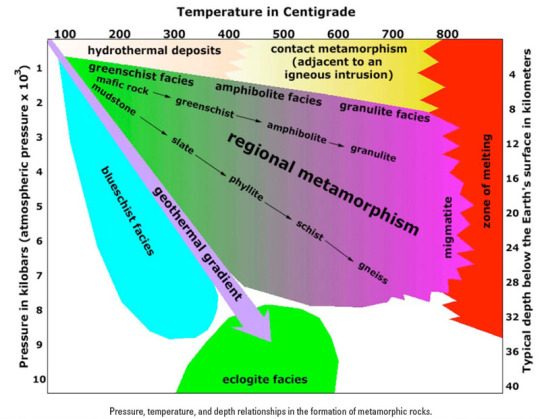
This image above has a lot of stuff going on...but it's got some useful takeaways. First: Metamorphism occurs over a WIDE range of temperatures and pressures. Second: different T and P regimes create different types of metamorphic rock. Third: The parent rocks, themselves, have unique compositions that react to changing T and P in different ways, creating unique mineral assemblages ("facies"). Fourth: Metamorphism has limits. If rock gets too hot, it melts. If it's not hot enough or if the pressures aren't right, the parent rock won't change at all.
So...how do we change T and P?
The Earth's core is hotter than the surface. The rate at which the temperature increases with depth is called the "geothermal gradient." The deeper you go the hotter things get. Pressure, called "lithostatic pressure," also increases with depth. If molten rock or really hot water touches existing rock, the heat from either is enough to alter it (contact and hydrothermal metamorphism, respectively). Geysers, like Gasket Geyser in Piston Peak National Park, are places where hydrothermal metamorphism can occur. Fun fact: the hot water fueling geysers is generally heated by molten rock deep under ground...so it's not all that uncommon for hydrothermal and contact metamorphism to occur in the same area.
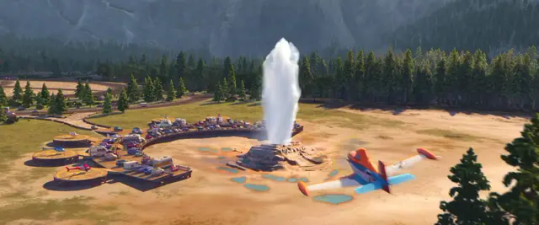
But...consider this satellite image of the Appalachian Mountains from space:
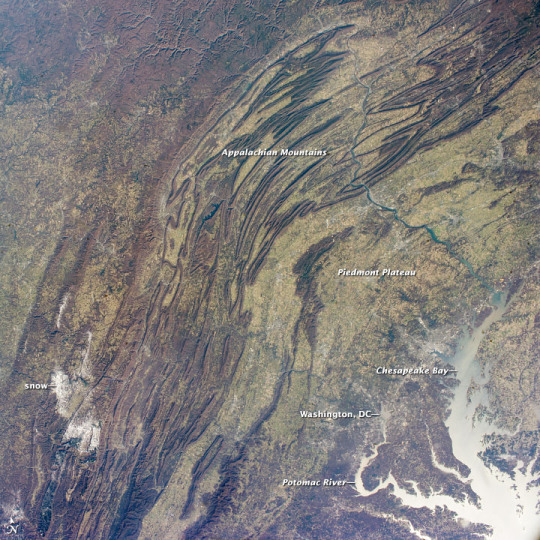
How did they get so squiggly when they're solid rock (and were solid even when they were being metamorphosed)?
The Earth's surface consists of large slabs of rock (called "plates") that are in constant motion. They are pushed and pulled by the rocks deeper down. At that depth, the rocks behave more like dense putty (tho not actually liquid) that moves up and down, heated by even hotter rock and metal deeper within the Earth. Wherever this "putty" goes the overlying rocks have no choice but to follow. The chemical composition of the plates varies from place to place, and depending on the type of rock and the way the plates interact along their boundaries, you can get everything from giant mountain ranges (like the Himalayas) to lush, volcanic islands (think Japan).
Nearly a billion years ago, various types of rocks began colliding with the eastern cost of ancient North America, resulting in a series of mountain building events that would go on to create a giant mountain range, stretching from modern Newfoundland in Canada to northern Georgia in the US. The rocks caught up in the middle of these events became warped and twisted forming metamorphic rock. They likely had a "coating" of sedimentary rock, however, once the mountain building processes stopped, water, ice, and gravity began to gnaw away at them, leaving behind their metamorphic skeletons.
You can think of the Himalayas as a newer version of the Appalachians. They're still growing as I write this, as rocks from the Indian Plate are smushed against rocks from the Eurasian Plate. Because the mountain range is so young, the "coating" of non-metamorphic rocks (sedimentary, in this case) is still present along some parts of the range, though they have been tilted and bent.
Real Himalayas


The Himalayas as depicted in "Planes."
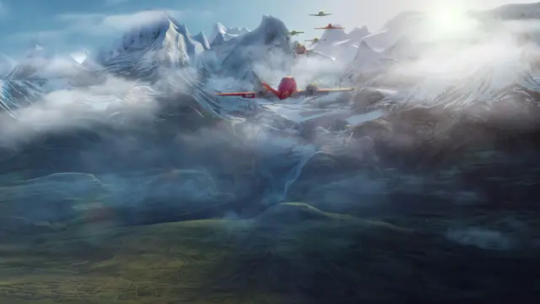
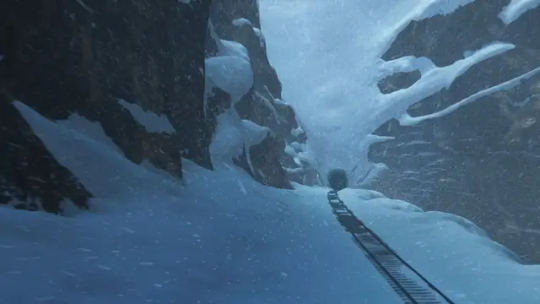
The Planes movies landscapes are a LOT more stylized than what we see in the Cars movies. Even so, they definitely captured the look of the range, and there are even places where you can see some layered sedimentary rock (as seen from snow laying in lines along the layers), like you see in the real Himalayas!
One thing I will note, here, is that the Appalachian mountains stop well north of Thomasville, Georgia (Smokey's hometown). In Cars 3, the area around Thomasville is more reminiscent of what you'd see in Kentucky or North Carolina. One of the images below is a screencap from Cars 3, the other is an actual photo taken in Magoffin county, Kentucky; can you tell which is which?
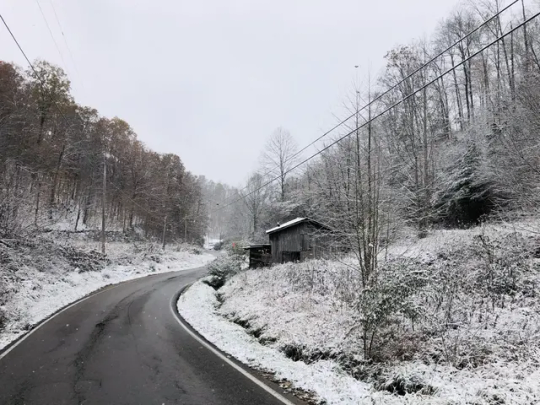

It's clear that they definitely wanted this rural, hilly aesthetic, but official artwork from Cars 3 (the poster below is is hanging up in the Cotter Pin) puts Thomasville in GA and not in NC.

More to come in part 2. :D
Thank you for reading!
#world of cars#cars#cars 2006#cars 3#cars 3 (2017)#cars fandom#cars movie#cars pixar#disney cars#pixar cars#disney planes#planes fire and rescue#planes#piston peak air attack#piston peak national park#gasket geyser#geology#metamorphic rocks#geology in cinema#pop culture geology#appalachia#appalachian mountains#himalayas#rocks#WOCgeology
63 notes
·
View notes
Text
According to highly cited conventional models, cooling and a major drop in sea levels about 34 million years ago should have led to widespread continental erosion and deposited gargantuan amounts of sandy material onto the ocean floor. This was, after all, one of the most drastic climate transitions on Earth since the demise of the dinosaurs. Yet a new Stanford review of hundreds of studies going back decades contrastingly reports that across the margins of all seven continents, little to no sediment has ever been found dating back to this transition. The discovery of this globally extensive gap in the geologic record was published this week in Earth-Science Reviews.
Continue Reading.
60 notes
·
View notes
Text
Top Seismic Data Processing Company for Energy Projects | Geomage
As a global leader among seismic data processing companies, Geomage delivers expert solutions for oil & gas, geothermal, and environmental exploration. Geomage’s technology ensures reliable imaging, fast turnaround times, and consistent interpretation results.
#geology software#seismic imaging#geological modeling#Best Geological and Seismic Software#Seismic Analysis Software
0 notes
Text
Pr and the Mniw
Pr is a minor planet orbiting the millisecond magnetar MMR CHA J1712-2901 ("Ast"), about a thousand light years from Earth, in the constellation Sagittarius. Ast has four major planets: Wsjrhp, Hrw, Mnw, and Bstt. Hrw has one moon, Jmstj. There are five large minor planet in eccentric orbits within 3 AU, Jrb, Bjr, Rrj, Zr, and Pr.
Planetoid
Pr is a large asteroid with a rotation period of about two hours; its average density is less than 4 g/cm^3, but its internal composition is highly variable. About 40% of its solid material is composed of massive diamond fragments fused together at seams formed of carbon glass, and the interior of the planet contains a large irregular cavern roughly 250 kilometers in radius. This cavern is sufficiently enclosed to retain an envelope of water and air with minimal outgassing. Due to the very high rotation speed of the planetoid, the surface of the cavern, at its lower levels, experiences a centrifugal force about 1-2% of Earth's gravity. The axis of Pr's rotation is nearly perpendicular to its orbit.
No complete model of the formation of the Ast system has yet been offered, but several hypotheses have been suggested to account for some of its more unusual features. The formation of a protoplanetary disk may be due to the disruption of a stellar companion, or fallback from the supernova that formed Ast in the first place; the diamond fragments which make up Pr may have originated in a disrupted carbon-rich planet or planetoid, or gas giant. The interior atmosphere of Pr is perhaps due primarily to biological processes releasing volatiles into the cavern.
Deliberate planetary engineering has been mooted as a possibility, but the crew of the DSE Scholiast, the only vessel to survey the system so far, has not yet found evidence of such engineering by other civilizations, and the indigenous inhabitants of Pr are likely incapable of such undertakings at this time.

[Map of Pr, with some regions and bodies of water labelled, plus many major settlements. The relief of the cavern interior is very great; the large plateaus have scarps tens or hundreds of kilometers high. Note that the equilibrium potential at the interior surface of a rotating body is cylindrical, not spherical, and this projection is adjusted accordingly, and so shows true shapes near the poles. The nature of the geological processes that have shaped Pr's interior are not fully understood at this time. The total land area visible here is roughly equivalent to Texas or the Iberian Peninsula.]
Biology and Ecology
Pr's internal heat is maintained by the radiation from Ast, which is converted to thermal energy in Pr's crust. Thinner regions of the crust, particularly near the equator, have higher heat flow from the exterior; the high axial tilt of Pr also means that the northern and southern hemispheres can experience somewhat different heat flows throughout the year. Much more important to Pr's seasons, however, is the variability of Ast's magnetic field created by the eccentricity of Pr's orbit. When Pr is closest to Ast, organisms can extract energy from the magnetic field, as Pr's rotation allows them to create selective ion gradients whose diffusion provides energy, or to directly extract mechanical energy from electrically charged cilia. (Induced current is much too weak to be a useful source of biological energy).
As on Earth, the native lifeforms can be broadly classified into producers and consumers, but even the consumers on Ast obtain a significant portion of their energy budget from autotrophy, using heterotrophy only to supplement this budget. A minority of producers are also radiotrophs, who extract energy from the radioactive elements in Pr's crust.
Pr biology does not use DNA and is highly resistant to radiation. It also does not seem to experience Darwinian genetic drift. Instead, cells seem able to adapt their own internal machinery in response to certain kinds of stress, and to disseminate these changes throughout the organism, or even to conspecifics. The nature of this process and how it could have evolved is still a mystery, nor can they apparently account for all of the different forms observed among the native life.
The interior of Pr is dim, but not dark. Some plant species have evolved to emit light as a form of signaling, incentivizing some animal species to evolve eyes in response.
Because of the energy inefficiency of pure heterotrophy, to say nothing of pure heterotrophy that involves predating on other heterotrophs, no carnivorous animals are known on Pr.

[Above, the Mniw. The upper Mni has a fully-grown set of skin-plates; the lower Mni has either shed or removed hers, possibly as a cosmetic choice. The dark patches of skin shown are the rough beds from which the skin-plates grow.]
The Mniw
The Mniw (singular Mni) are the indigenous inhabitants of Pr. They are 12-18 centimeters long, with tough gray skin, and usually found with a mineralized defensive covering that grows out from the skin. They have a single sex, and reproduce via parthenogenesis. However, they still engage in a form of sexual intercourse, which is divorced from reproduction: instead, sex among the Mniw exists as a means of facilitating horizontal gene transfer, which then alters the nature of the offspring they bear. It can also allow a limited sharing of experiential memory. In addition to sight, hearing, and the other usual senses, the Mniw have the ability to sense the weak induced electrical currents in Pr's crust, which helps them perceive their environment better.
Mniw hatch from eggs and are generally raised in family units; they do not make sex-based distinctions, but do make social distinctions based on relationships. A mwt is the Mni who laid the egg; all other adults in the same household involved in childrearing are jtw; the sntw are siblings who share a mother, while other children raised in the same house are snw. Children from one's own eggs are srtw, while children from one's partner(s) are mnw.
As in humans, Mni adolesence is marked by gradual sexual maturity; reproductive fertility comes later in life, however, around the age of 30. Past 50, fertility declines slowly, as does the capacity to engage in horizontal gene transfer, though the capacity for sexual intercourse remains. Past 65 or so, Mniw enter their equivalent of "old age," but Mni do not experience a sudden collapse in their physiological health late in life, and can in principle life forever so long as they are not felled by accident, violence, or disease. In practice, lifespans are around 130-200 years, with a great deal of variability.
Mniw have many social elements, like hierarchy and emotions and social roles, that would not be entirely alien to humans, but they have no direct analogue to human sex roles or orientations. Instead the major cleavage in Mni society historically is between Mniw who tend to be primarily exogamous, preferring to mate and rear children with Mniw from distant communities, vs Mniw who tend to be primarily endogamous, with about 85% of Mniw being primarily endogamous; these traits perhaps evolved in the context of horizontal gene transfer to take advantage of different patterns of dissemination of useful traits.
Mniw can survive outside of Pr, but without a strong, moving magnetic field must consume a large amount of food; and the food they are normally adapted for will not grow at all absent such a field. An Earth-standard gravitational field would render them totally immobile, and would be extremely unpleasant, though probably not fatal, and it's possible given their unique physiology that they could eventually adapt to such an environment.
Mniw generally inhabit large, almost hive-like cities that are built out in three dimensions; historically, these could be strongly fortified against attack in a way that made wars of conquest nearly impossible until the invention of gunpowder. Mniw have had writing for about 5,000 years, and the first confederate states emerged around 3-4,000 years ago. The dissemination of gunpowder weapons 1,500 years ago radically altered politics and society on Pr, but the absence of easy paths to industrialization has caused a certain degree of stagnation since.
Modern Pr is divided into about a dozen large states, in an area of roughly 750,000 kilometers square, with a fair amount of diversity in languages, cultures, and social systems, given the small size of Pr. A very loose framework of international diplomacy is carried out through a series of councils called the Jaw Mwad, and on the occasion of the Scholiast's arrival, the Mniw convened a great council, a Wr Jaw Mwad, for the first time in over a century to open formal channels of communication.
#tanadrin's fiction#speculative evolution#speculative biology#tanadrin's art#pr and the mniw#conworlding#life on a pulsar planet
60 notes
·
View notes
Text
Two of my photos of bighorn sheep. First photo in Whitewater Canyon, second in Tahquitz Canyon, both near or in Palm Springs. They were a little too close to me for the second photo, and they're both large (and older) males, and it was rutting season, so I was a bit nervous.


Excerpt from this story from The Revelator:
A long piece of grass hung loosely from his nose. He looked down at me from his mountain perch, about 500 feet away from where I stood. Staring at his amber eyes, I wondered how many lurking mountain lions this Rocky Mountain bighorn sheep had outwitted in his Colorado National Monument home. He’d also have battled male sheep: Hard-fought clashes to snag prized females have whittled down the edges of his imposing horns, which are etched with deep rings. Like trees, bighorn sheep generally develop one ring on their horns for each year of life.
As I scoured the ancient red cliff faces with binoculars, I noticed that he wasn’t alone. Two young rams, about 20 feet away from him, reclined on a ledge, their spindly legs tucked under lean bellies. One closed his eyes, twitching his erect ears, as if adjusting them to tune into his surroundings.
The sheep appeared at peace, as was I, listening to birds chirp and the wind rustle. No rumbling vehicles pierced the silence in this 20,500-acre monument that sits in the western corner of Colorado.
The monument is ideal for bighorn. Rock formations tower into geologic skyscrapers, as if a giant playing Legos has stacked round and square rocks on top of each other. Over billions of years, wind and water — nature’s artists — sculpted the cliffs and mountain ranges into their present-day shapes.
The Park Service mantra echoed in my mind — public lands belong to us.
But that begs the question, what about wildlife that make their homes in public lands? A modicum of etiquette enforces the notion of acting with care and consideration when visiting another’s home.
Perhaps that same respect could extend to wild homes in national parks and other public lands. Modeling the success of the 2016 Park Service centennial, a new campaign could endorse a different mantra: a plea to the public to protect and respect wildlife and their homes. The Park Service could carve out natural preserves that are specially designated for wildlife where the public has no access — areas where animals could be truly free.
“Without human interference, wildlife can thrive,” Sloan emphasizes.
Bighorn and other species need this freedom more than ever. In the wake of the centennial campaign and after the pandemic, National Park attendance continues to soar. In 2023 it reached 325 million people. How can animals persist at that level of constant human presence?
I thought about that while watching the bighorn at Colorado National Monument. A tumbling rock whacked a cliff face, yanking me back to the present. The elder ram rested comfortably on a ledge next to a spiky cucumber-colored yucca, peering over the landscape like royalty.
This is his home, I reminded myself. Walking back to the car, I turned my head and took one last look at him, grateful for time in his presence. He watched me leave, perhaps with a sense of relief.
33 notes
·
View notes
Text
An AU where the Cutie Mark Crusaders and Discord swap places/roles.
The CMC becoming a trio of Draconequis that represent different facets of chaos. Apple bloom representing life. Sweetie Belle imagination and creation. And Scootaloo weather and geological events. The three enjoying causing chaos across the new kingdom of Equestria. Eventually being turned into stone by the Celestial Sisters.
Discord is a young foal who has yet to get his cutie mark and has been causing quite a lot of chaos in looking for it. Taken in by the main six to hopefully teach him better ways of coping with his desire to find his destiny, to help tame his chaotic magic, and to hopefully give him good role models in his tumultuous life. He is a well meaning trouble maker. He looks up too pinkie pie, rainbow dash, and Twilight sparkle the most.
#my little pony friendship is magic#drawing prompt#writing prompt#alternate universe#mlp#mlp au#mlp fim#mlp alternate universe#mlp fim discord#discord mlp#mlp discord#discord#mlp fim cmc#mlp cmc#mlp cutie mark crusaders#cutie mark crusaders#mlp apple bloom#sweetie belle#mlp scootaloo
25 notes
·
View notes
Text

Transmechanicus Xenologis Field Report
Study Log Entry: 961.M41
Subject: Planetary Survey of Nullius-57, Orkoid designation “Og”
By: Magos Xenologis Xanthor Vell (Excommunicated)
Location: Segmentum Obscurus, Uncharted Subsector
I. PLANETARY CLASSIFICATION
Imperial Registry: Nullius-57 (Unofficial)
Orkoid Designation: Og — interpreted as “Owned by / Property of” in local feral Ork dialect
Segmentum: Obscurus
Planetary Type: Oceanic-Terranic hybrid
Size: Approximately 108% of Terra’s equatorial diameter
Water Composition: ~80% of the planetary surface
Orbital Characteristics: One sun (G-class), two moons in stable orbit

(I gave up, I don’t know shit about how to draw ocean currents)
II. TIDAL AND CELESTIAL DYNAMICS
The gravitational interplay between Nullius-57’s two moons creates unusually complex tidal patterns across the planet’s oceanic surface. These include:
• Multi-directional tidal surges
• Semi-diurnal hyperwaves in coastal and archipelagic zones
• Periodic tidal inversions recorded every 31 standard cycles, potentially responsible for cyclic mass migrations among aquatic fauna.
The planet lies within an uncharted zone of Segmentum Obscurus, likely masked from long-range Imperial auspex by stellar anomalies and warp turbulence—an ideal breeding ground for unrecorded evolutionary branches.
III. ATMOSPHERIC CONDITIONS
Atmospheric Density: ~1.3 atm (approx. 30% denser than Terra)
Primary Composition:
• Oxygen: 25–27%
• Carbon Dioxide: 3–4%
• Nitrogen, argon, and trace exotic gases
The thick, oxygen-rich atmosphere contributes to:
• Enhanced metabolic efficiency among local xenos species
• Higher combustion rates and volatile respiration thresholds
• Amplified fungal spore propagation due to sustained humidity and pressure
IV. PLANETARY GRAVITY AND FAUNAL ADAPTATION
Gravity: Approx. 0.38g (similar to Mars)
Despite the low gravity, native organisms have adapted in ways that defy standard models:
• Most fauna exhibit eight-limbed arthropodal symmetry, maximizing traction and momentum in low gravity
• Chitinous exoskeletons are dense and layered, likely evolved to compensate for the reduced structural strain
• Muscle fibers in larger fauna (e.g., Gargantuan Hammerfist Champignat) are hypertrophied and heavily vascularized, allowing for sudden explosive bursts of movement uncommon in similar gravity environments
The most significant observation remains the presence of Orkoid species as the only vertebrates. Whether artificially introduced or the result of a rare fungal-vertebrate divergence is still unknown, but their survival and dominance suggest a biome unusually hospitable to Ork physiognomy.

V. GEOLOGICAL STRUCTURE
Tectonics: Mildly active. Continental plates are fragmented but remain in proximity, indicating a prior supercontinent stage reminiscent of Terra’s Permian Pangaea.
Seismic scans reveal:
• Major fault lines still align radially around a central continental cluster
• Shallow subduction zones suggest ongoing but non-catastrophic geological drift
• Volcanic vents support a thriving thermophilic fungal biome, primarily near the equator
VI. CLIMATIC ZONES
Overall Climate: Humid and warm with minimal axial tilt, resulting in very limited seasonal fluctuation
• Equatorial Regions: Tropical with intense fungal overgrowth, average temperatures exceeding 34°C
• Polar Regions: Only moderately cooler, sustaining dense fungal tundra variants
• Rainfall: Near-constant in some biomes due to atmospheric pressure and oceanic evaporation patterns
VII. PLANGUS FLORAL BIOME (FUNGAL-PLANT EQUIVALENT)
Termed “Plangus” by my own designation—a portmanteau of planta and fungus—this fungal flora fulfills all major ecological roles of photosynthetic plant life.
Photosynthesis-analog Process:
• Utilizes green and blue pigmentation in chlorophyll-analog proteins (tentatively classified as Mycophytochrome-X)
• Plangus spore sacs open during peak solar periods to engage in gas exchange and UV absorption
• Bioluminescent varieties assist in nocturnal photosynthesis via energy storage in phosphorescent organelles
Color Morphology by Region:
• Highlands: Deep green and violet Plangus carpets, heavily mossed
• Lowlands: Amber, red, and orange fungal caps with wide lamellae for water retention
• Equatorial Swamps: Translucent white and yellow luminescent fungal towers, growing up to 40 meters
These fungal flora are crucial to nutrient cycling, oxygen production, and even psychotropic symbiosis observed in some mollusk-xenos.
VIII. LOCAL FAUNA
The dominant faunal archetypes fall into two categories:
• Arachnid/Insectoid Xenos: Eight-legged, armored, ranging from micro-scale scavengers to titanic apex predators such as the Gargantuan Hammerfist Champignat
• Molluscoid Xenos: Ambulatory, highly adaptive, semi-amphibious; many exhibit Plangus symbiosis for healing and camouflage
Orks:
The only vertebrate genus present, suggesting:
• Exogenic seeding (possibly via crashed hulk or rogue Sporeship)
• Exceptional fungal adaptation due to their own mycoid origin
Local tribes of feral Orks claim sole ownership of the planet, hence the name Og. This linguistic possessiveness hints at a deep instinctual bond between Orks and this fungal-rich environment, perhaps even more intense than typically observed on Ork-held worlds.
CONCLUSION
Nullius-57, or Og, is a world defined by a dense atmosphere, low gravity, and a unique fungal biosphere whose adaptive extremity borders on the miraculous. Its faunal and floral life appear to have evolved in tight biological concert, and the complete lack of vertebrate diversity—barring the Orks—raises fascinating evolutionary and possibly technogenic questions.
I suspect the planet may have once served as an ancient fungal cradle world, or perhaps even a lost Ork spawning ground from millennia past. In either case, Og is not merely owned by the Orks—it thrives because of them, and perhaps they because of it.
End of Entry
Magos Biologis Xanthor Vell
In Defiance of the Omnissiah, In Pursuit of the Green Truth
#warhammer 40k#my art#orks40k#ork world building#worldbuilding#scifiart#drawing#worldbuilding project#digital art
19 notes
·
View notes
Text
Walking With Dinosaurs 2025 is bad, and here's why
I was so excited for Walking With Dinosaurs 2025. So Excited. I called up some friends, I ranted and raved online, I rewatched the originals, (all of them (yes all of them)) I made up a cheese platter and got myself prepared to have a good time.
I did not have a good time.
It’s bad, it’s really, truly, horrendously bad. Not only is it a bad documentary on its own merits, it has managed to completely miss the point of what made the originals special! When I ranted to my Father on this topic, him, knowing my childhood obsession with this series, said to me “well, it’s a bit naff, but you’re not twelve anymore, they aren’t making it for you,” and I am here thinking, bi-eloved Father, if they aren’t making it for me then who the fuck are they making it for? Certainly not anyone who liked the original series! And if the original series didn’t hold up then, you know, maybe it wouldn’t have been viewed by tens of millions of people, and kicked off a revolution in paleontological documentary making, and spawned three additional tv specials, a sequel series, a prequel series, another sequel series, another worse sequel series, a feature length film that I am Not going to acknowledge ever again, another entire series of mockumentaries that were only tangentially related, a sequel to that, a fictionalised drama spin-off of THOSE mockumentaries, then a Canadian spin-off/adaptation of THAT series, a video game, and a multimillion dollar Live Arena Spectacular with diesel powered lifesize sauropod puppets? The Walking With- franchise did not become what it is because it’s audience was twelve, it was because it was good, and they endure because they were well made, and did something bold and interesting that no one else had done, and this new spin off has just, shat all over that, and because I have a blog now I guess I’m gonna rant into the void about it until I feel better.
To start with I’ll get down to the biggest issue of all, the format. The defining thing of the Walking With’s was that they presented themselves as a “live” documentary. Instead of showing us fossils, and talking about what could have been, they showed us an animal, and say this is what is. This is a dinosaur, here is its life. It was all framed as if made about something “alive.” It did not waste time with quibbles about how arrived at their interpretation of the fossils, or justify their decisions, they never broke the illusion that these animals alive, hence “Walking With-” were walking with them, in their footsteps, following their lives. They expected you to use your critical thinking skills to know that it is supposition (and they released a comprehensive book detailing why they made the decisions they made and the science behind them if you cared that much.) WWD 2025 takes all of that and throws it in the bin.
It opens on silhouette of a cow person in Montana, not a great start, and then finally moves to a dig site. In what formation? Not important, apparently. What geological era? Who cares? It’s not like anyone watching a documentary about dinosaurs will care about something as trivial as that, right? Then a pair of mysteriously made up and sweat free paleontologist dig up a bone that has been mysteriously cleaned and prepared ahead of time. We are told it is an infant triceratops that they have named Clover, and she is on her own. They could have told us this by just showing the “live” dinosaur, but, they get to the point pretty quickly so I could have lived with that. Oh, if only I had known what was to come.
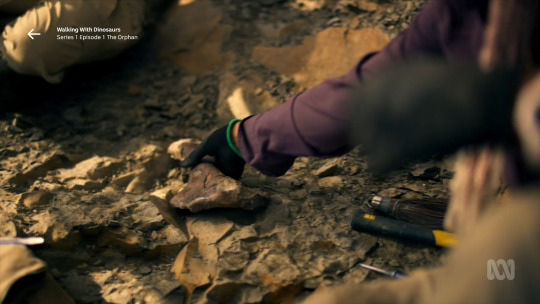
This is how you get fossils out of the ground right? Just pick them up? So nice of them to glue themselves together in situ.
We finally see Clover and, she looks terrible. Don’t get me wrong, the model and texturing is very good, she looks beautifully scaly and her body is plump and fat as you’d expect a young dinosaur to look, but the movement is just terrible. All the dinosaurs, outside of a few key scenes, have this incredibly stiff, rigid movement, they turn their head, stop, blink, flinch back to the first position, then repeat. They look and move like animatronics, almost more so than the animatronics of the original did at times when the camera decides to focus inexplicably on the same sequence of short looping movements. Her nostrils do not flare when she investigates the nest of eggs, her pupils do not pin when she is playing, her plump, fat belly does not sway or jiggle as she frolics, she leaves no footprints in the sand, no ripples in the water, she does not pant or cry or emote in any way beyond jerking her head back and forth and leaping with her feet out of frame to save money on animation. She is stiff, and unyielding, and unalive. Then, after a whole three (3!) minutes with her, we’re back at the digsite digging up another fossil that was definitely prepared earlier.
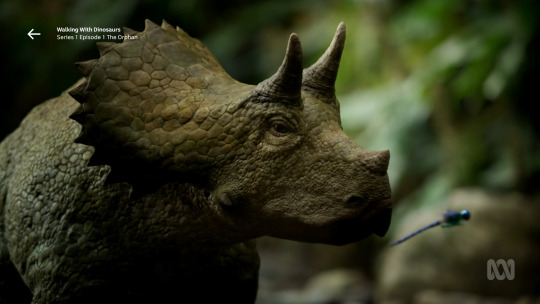
Get prepared to see this lifeless head bobbling a lot.
It’s her jawbone. It’s a very beautifully prepared jawbone too. They’re so proud of this find that the narrator introduces us to the palaeontologist who prepared it, all this only six minutes after they picked up the perfectly prepared femur out of the ground like it was just like that, right in front of her. Why? Do, do you think our memories are so short that we’d forget? Either you’re pretending it came out of the ground that way, or this lady prepared it, you can’t have it both ways because the only way to have that is to excavate it, send it away to be cleaned and prepared, then bury it again, and that’s just a stupid thing to do (so of course they did that) and why did they do this? To show us that her teeth weren’t worn down yet, so we can tell that she is definitely babby :) This is all after showing us her femur that already confirmed her size, showing us the animated model contrasted against insects and plants for scale, and stating, in the narration, that she is a youngster the size of a dog. It’s just pointless filler. If you wanted to show off her teeth that bad, maybe tell us about her diet? Just a thought.
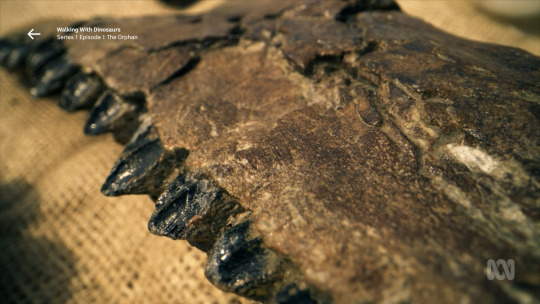
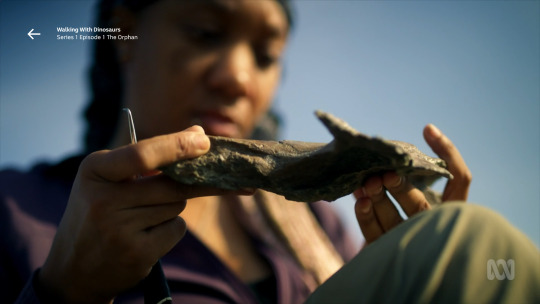
Yeah, you totally cleaned and prepared that fossil onsite with that immaculate, never used hand tool.
The show goes on like this for a while, three minutes of babby dinosaur jumping around, not doing much of anything, four minutes of freshly showered, not-sunburnt paleontologists digging up preprepared fossils and padding the run time by talking about things we already know, because the show just showed it to us (hence why we call them shows) but they have no faith in us to remember things for more than three minutes.
Then the T-Rex shows up for the second time (the first encounter with the infernodrakon was so silly and jerkily animated I’d rather just forget it) and you can get a tiny glimmer of the spirit of the original. Its shot at night, so the pain points of the animation are hidden by the dramatic, shadowy lighting, and it sets up an interesting premise, T Rex has excellent night vision, triceratops does not, so now we get to see one of the most famous and beloved predators of all time in their natural element, lets go!
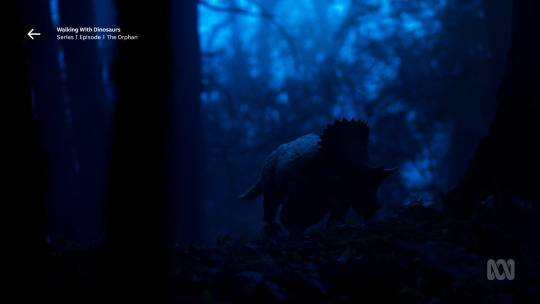

They do look so lovely in the moonlight.
She steps on a stick immediately, and Clover sees her in the dark, despite the narrator telling us that she can see extremely little, and manages to outrun a bloody T-Rex without any apparent struggle at all, then she runs into a convenient hole in the ground (without being able to see it, somehow) and we spend the next two minutes watching the T-Rex ram it’s face into a hole it can’t fit it’s body through and snapping on air while its legs kick uselessly behind it. This isn’t Walking With Dinosaurs, this is the one good scene from Meet the Robinson's, only we aren’t supposed to be laughing.

At this point I have officially checked out, and the paleontologist decides to whip out their 3d printer and print up a brain case of a T-Rex, and tell us about how they aren’t very smart and how their senses are very sharp and yada yada, just rehashing and justifying the decisions they made three minutes ago because they have less faith in their audience’s intelligence than I do in the Trump administration’s and they need to pad the runtime. It continues in this manner, three minutes of dinosaurs, four minutes padding, and I begin to daydream of fossilisation.
Finally Clover finds a small group of Edmontosaurus and herds up with them for a while, mixed herds are pretty accepted science at this point so I don’t see any reason to be surprised, but then the animation gets really, really bad. The trees the Edmontosaurus are eating are clearly animated over the top of the environment, and as they graze these branches squash and stretch in a way that is really obviously unnatural to the eye, and as they tear leaves off there’s no refuse, no needles fall, no dust flies up into the light. In the original, they would make a point to film the environmental interactions they needed in the actual environment, they’d wear dinosaur foot shaped boots to kick up dust and make footprints in the sand that would be animated over later, use poles to splash the water as their dinosaurs drank, they’d dress men up in black bin bags and send them into the swamps to jump about and make ripples and splashes, they’d tie fishing line to branches and pull and shake them to make the trees move and shed needles as they were eaten, but fishing line wasn’t in the budget apparently, nor particle effects.
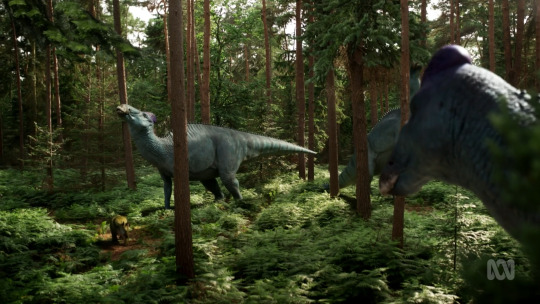
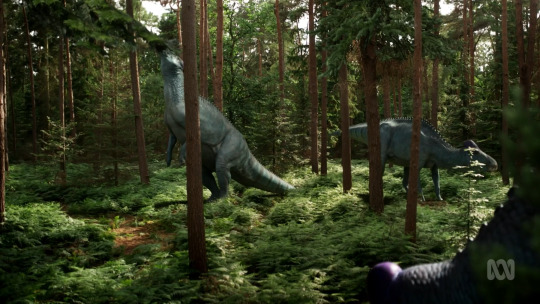
If any gif makers out there want to rip and gif this I would appreciate it. The sheer levels of ps2 on display here cannot be captured in screenshots.
Thankfully they don’t dwell on it for more than a few seconds, because all that money they saved went toward making a baby edmontosaurus model! One conveniently just Clovers size in the herd that is her playmate and after interacting for ten seconds they nuzzle like this:
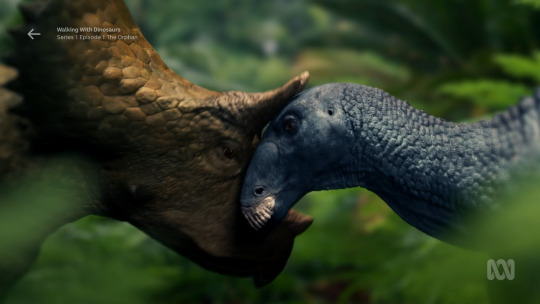
No, no fuck off. They did not do this. I refuse to believe it. Not because I don’t think dinosaurs could have nurturing and complex social relationships, but because this fucking show has put in none of the work. We don’t see any other pair of dinosaurs interact in this way. When Clover meets another Triceratops she head-butts it with her face and bleats, the adult edmontosaurus almost never interact with the baby at all, and this is by far the smoothest and most natural motion I’ve seen two dinosaurs make in this entire episode, and it’s a meaningless, baseless contrivance they made so they could put a cutesy clip in the trailer. The playmate gets eaten in the next three-minute segment, and the edmontosaurus “move on” and Clover just doesn’t go with them for some reason. They don’t bother explaining why, it’s a thing that needs to happen so it happens. What a joke. Then the paleontologists are back with a huge coprolite and talk about how they know that T-Rex must have eaten small infant dinosaurs because of the bone fragments in the coprolite, as if we can’t intuit that from what we were just shown, when the T-Rex avoided the large, strong adults to attack the weaker young, or, from the fact that that’s how almost every living predator behaves. What a load of coprolite.
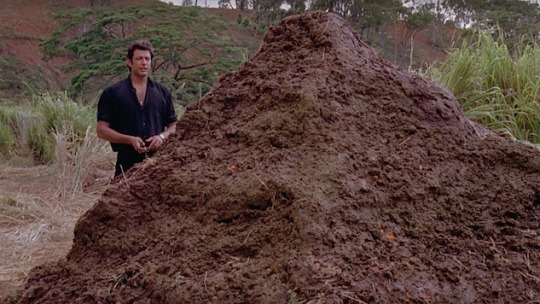
When the Edmontosaurus “move on” and Clover does not, she is once again alone and vulnerable, how sad! But, we're running out of time, so they decide to throw everything they just set up in the bin by contriving a confrontation between the T-Rex and a bull Triceratops to end the show on a bang, and the T-Rex just, does this. It's not trapped, its not in some sort of hormonal cycle or injured and unable to chase down prey, they just decide to make this animal, which they just took great pains to show to be intelligent enough not to pick a fight with a healthy adult dinosaur when there were other options, stand its ground and fight this Triceratops, just, because. So there is a painstakingly slow, awkwardly animated, gunslinger style stand-off with the Triceratops (which they interrupt twice to explain that Triceratops have these frill things, ya see, like we haven't been looking at one for fourty minutes,) and then it just stops, and stands there, and the triceratops skewers it to death, because that’s what we wanted right? The good herbivores to triumph over the evil carnivore? That’s how nature documentary’s work, right? White hat vs black hat? Is that not how you wanted this to end?
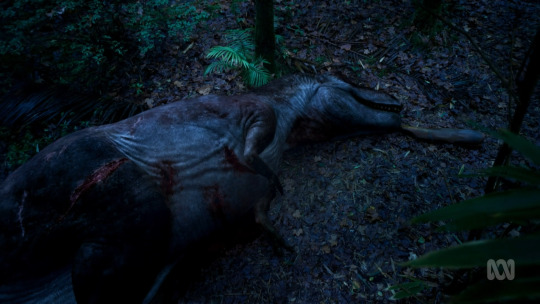
God I wish this were me.
Then they wander into the distance, with the narrator comfortingly telling us that while we don’t know what happened to Clover, we know that she wasn’t eaten by a T-Rex because if she had been she wouldn’t be a fossil. No, she’s just going to slip down a muddy river bank in the next few minutes and drown to death on a nice bed of alluvial sediments. They already told us she died very young, they showed us her bones! Bones that were the same size as her animated model. This is not a happy ending, because we are capable of remembering the things we are told, for long periods of time, even! The only thing that’s changed is that we have two dead dinosaurs now, along with any joy that was left in my soul.
It’s just bad, so very, very bad. It’s bad at everything it tries to do and those elements combine to make a whole that is uniquely worse than the sum of it’s parts! It insults the original series by using its name for a product that has none of its soul in it at all, and it insults the intelligence of its audience by wasting their time, explaining and explaining the same obvious fun-facts over and over, and trying to stretch a twenty-minute experience into fifty minutes of runtime and hoping we won’t notice that they have nothing to say.
What really gets me is that the whole “digsite to recreation” style of dinosaur documentary is already a thing, and a popular thing! When done well it’s very, very interesting, because the practice of paleontology is interesting! The first one that comes to mind is Dinosaurs: The Final Day as presented by the treasure that is David Attenborough. It shows us a dig site, a real dig site, the tedious, and difficult art of excavating it, the joy and wonder of the paleontologists as the splendor within is revealed, and then goes into detail about what these finds are, what we can learn from them, and then, and only then does it show us what that might have looked like with a recreation. This order of operations is important! By showing us the evidence first we are better able to understand what we’re being shown to us in the recreation, and it builds the tension, we wonder what does this mean, what can this tell us, what was it like? and then the show answers our questions in a big, climactic, and satisfying way. By showing the recreation first, then breaking the flow of the story to show us their contrived reasoning behind it, not only does it erode any ability I had to care about the story being told by the recreation with the constant interruptions, it’s no longer answering a question, because we don’t have the time to really ask any! We are showed a narrative, and then we’re pulled out of the narrative so that the author can show us his citations and talk about how very hard he worked and how smart he is and how good his movie is, because it is correct as well as cute, and it does this every three minutes. Imagine if you were watching The Godfather, and every five minutes That Guy who is sitting next to you pauses it to mansplain about the symbolism in the background that you absolutely must understand if you want to enjoy this movie properly, because it’s so deep you know, here have you done the reading? Oh you should watch this video essay first so you can understand the subtext here, just let me…
They just, do everything wrong. If they only had the budget for twenty minute episodes, then make twenty minute episodes! It would have been easier to swallow than this. Maybe its excessive to spend more than two thousand words rambling about this thing, but damn it, I care about this franchise and I know I’m not the only one! I’m almost curious about the second episode. They’re doing Spinosaurus, a dinosaur with a famously controversial and divisive history, and I’m curious if they’re going to go digging up any other prepared fossils when the Spinos only type specimen was famously blown to smithereens in WW2, it would be quite a feat, that. Though, if I’m honest with myself, I think I’d rather watch Nigel Marvin drive his ute through time again. He treated his audience with so much more respect than this show does.
#rant#Critique#walking with dinosaurs#My disappointment is immeasurable and my day is ruined#Walking with dinosaurs 2025#Episode 1: The Orphan#triceratops#tyrannosaurus rex#tw: animal death#Walking With series#dinosaurs#documentaries#paleontology#paleomedia#Maybe this is too many tags idk#I'm mad and I want my yelling to be heard a little maybe
12 notes
·
View notes
Text
Heritage News of the Week
Discoveries!
As construction crews churned up dirt to renovate a football pitch in Vienna last October, they happened upon an unprecedented find: a heap of intertwined skeletal remains in a mass grave dating to the first-century Roman empire, most likely the bodies of warriors killed in a battle involving Germanic tribes.
Obsidian artifacts unearthed in Alberta offer new clues on prehistoric trade routes
Inky black shards of volcanic glass unearthed in Alberta are helping researchers trace the movements of Indigenous people across Western Canada centuries ago.
“House of Life” among new discoveries at the Ramesseum
A joint French and Egyptian archaeological mission has made several major new discoveries at the Ramesseum, the mortuary temple for Ramesses II.
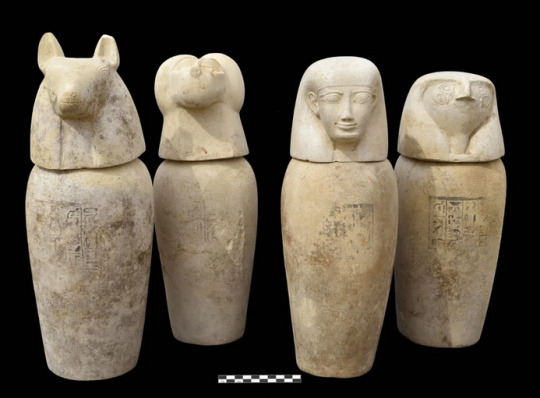
Walls of ancient Greek colony of Selinunte discovered
Italian authorities announced a series of new discoveries at the site of Selinunte that underscore the city’s illustrious past
A life-sized statue of a bejeweled ancient priestess is unearthed in Pompeii
Archaeologists in Pompeii have made the astonishing discovery of two life-sized relief sculptures of a man and a woman draped in classical robes. The pair, possibly husband and wife, stand within a niche on the boundary wall of a monumental ancient tomb.
Ukrainian soldiers unearth ancient Greek burial
Ukrainian soldiers digging defensive fortifications stumbled upon an ancient Greek burial site in southern Ukraine.
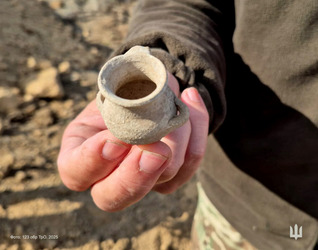
Tiny pot!
Ancient mausoleum with gladiator’s epitaph unearthed in Italy
Archaeologists excavating a necropolis in Liternum Archaeological Park in Campania, southern Italy, have uncovered two ornate funerary enclosures, one of which belonged to a gladiator and bears an epitaph etched in marble.
Researchers study erratic boulders from Frosh Giant legends
A study funded by The National Science Centre, Poland, has analysed both the geological and mythical origins of the erratic boulders scattered across northern Poland.
Rare wall paintings found in Cumbria show tastes of well-off Tudors
Rare and fantastical 16th-century wall paintings which shine light on the interior design tastes of well-off Tudors have been revealed in a former hunting lodge.
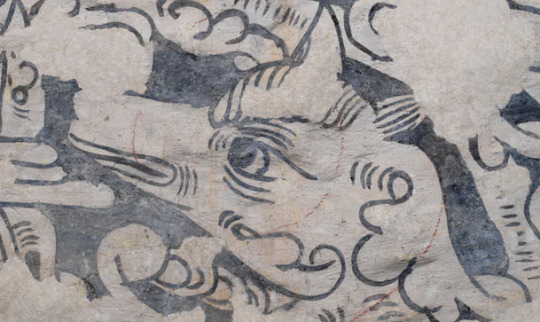
3-year-old picks up 'beautiful stone,' discovers 3,800-year-old scarab amulet in Israel
A 3-year-old girl who was walking with her family along a trail in Israel unexpectedly found a piece of history: a 3,800-year-old scarab amulet.
Extensive Roman settlement found beyond the borders of the Roman Empire
Archaeologists excavating in Delbrück-Bentfeld, northwestern Germany, have uncovered evidence of an extensive Roman-era settlement beyond the borders of the Roman Empire.
More caves discovered in Nottingham’s hidden subterranean world
Nottingham, nestled in England’s East Midlands, is famously known as the legendary home of Robin Hood. But beyond its folklore, the city also boasts the UK’s largest network of caves, carved by hand into the soft sandstone bedrock as early as the 9th century AD.
Stunning reconstruction reveals warrior and his weapons from 4,000-year-old burial in Siberia
A new full-body reconstruction depicts a warrior wearing armor and holding weapons, all of which were found in a 4,000-year-old burial in Siberia.
Hallstatt dagger discovered on Baltic Coast
Researchers from the St. Cordula Association for the Protection of Monuments have discovered a rare Hallstatt-era dagger, revealed after a storm caused a section of a Baltic Sea cliff to collapse.
Unknown human lineage lived in 'Green Sahara' 7,000 years ago, ancient DNA reveals
Researchers analyzed the ancient DNA of two mummies from what is now Libya to learn about people who lived in the "Green Sahara" 7,000 years ago.
AI assists archaeologist in mapping Angkorian-period structures
Archaeologists have created deep learning models, specifically with DeepLab V3+, for semantic segmentation to identify previously unknown reservoirs from the Angkor period.
Researchers posit new theory about children's role in prehistory
A new study suggests that children may have played a special role as mediators between the physical and spiritual worlds,
Traces of Ecuador’s first colonial-era city unearthed in Riobamba
Archaeologists from Ecuador’s National Institute of Cultural Heritage have uncovered remnants of an early colonial-era city that was destroyed by a devastating earthquake in 1797.
Oldest vanilla pod in Europe found in Prague
Excavations within Prague Castle yielded the oldest vanilla bean pod in Europe. Radiocarbon dating indicates that it was placed there between 1513 and 1666, a time that coincided with the reign of Holy Roman Emperor Rudolf II.
Museums
From Guy Burgess’s briefcase to microdots secreted in talc, an exhibition reveals remarkable items from the agency’s archives – and the extraordinary stories behind them
Take two Van Goghs daily: the growing popularity of museum prescriptions
Research backs schemes that encourage doctors to prescribe time in cultural institutions to boost mental health and reduce loneliness
Smithsonian director pledges museum’s independence amid White House order of internal review
The Smithsonian Institution’s leadership is standing firm after the Trump administration ordered a review last month of its exhibits, accusing the museum network of pushing a “race-centered ideology.”
Dozens of museum agency workers put on leave amid Trump overhaul
Processing of 2025 grant applications has been halted after Trump moved to dismantle the Institute of Museum and Library Services.
US museums seek to provide safe spaces for LGBTQ+ communities amid government rollbacks of their rights
As Republicans and the Trump administration target DEI initiatives and queer and trans communities, vocal leaders at a few institutions are standing firm
Three historical treasures rescued from London’s River Thames
Thanks to the efforts of mudlarks, Londoners can marvel at Tudor headwear and an elaborate Viking weapon.
God, I wish I could see this exhibit
'Last in England' smashed medieval statue recreated
A 15th century statue that was found smashed into 170 fragments behind a church wall has been painstakingly pieced together using computer animation.
Museums in southern Brazil still recovering after last year’s floods
Damage and destruction decimated visitor numbers to cultural events and institutions last year but optimism is high they will return in 2025
Yorkshire Museum crowdfunds to acquire ‘game-changing’ iron age hoard
The Yorkshire Museum in York is close to raising £30,000 through a crowdfunding campaign to acquire a major iron age hoard recently discovered in the local area by a metal detectorist.
Medieval scroll found in shoebox goes on display
A rare medieval illuminated manuscript uncovered in the archive of a York convent is going on display for the very first time.
Museums are losing social media followers amid users' mass X-odus
Some institutions have ditched their accounts in protest, while others have chosen to “quiet quit” and stopped posting on the Elon Musk-owned platform
Repatriation
The famed museum recently returned a 12th-century Buddha sculpture that it says was stolen from the Kathmandu Valley. However, the institute’s announcement failed to mention the statue had once belonged to wealthy donor Marilynn Alsdorf.
Heritage at risk
Videos of Sudan’s national museum showing empty rooms, piles of rubble and broken artefacts posted on social media after the Sudanese army recaptured the area from the paramilitary Rapid Support Forces in recent days show the extent of looting of the country’s antiquities.
EPA head shutters agency’s National Environmental Museum
In a statement issued on March 31, EPA administrator Lee Zeldin said the closure would save taxpayers about $600,000 per year. The small museum was created in 2016, dedicated to the nation’s environmental history, and included exhibits about prevention measures during the Covid-19 pandemic, environmental justice, and efforts to address climate change.
$600,000 a year is like one day of the military budget
ETA: I have been informed it's actually less than 30 seconds of the daily military budget o_O
Historians condemn executive order targeting Smithsonian
The American Historical Association, a D.C.-based advocacy group, has issued a statement condemning a recent White House executive order targeting the Smithsonian Institution, which relies on federal funding to drive a significant part of its operation.
New York Attorney General sues Trump administration over museum and library funding cuts
New York State Attorney General Letitia James has filed a lawsuit—alongside 20 other attorneys general—against the Trump administration over an executive order that effectively shuts down three federal agencies responsible for supporting libraries, museums, minority-owned businesses, and labor mediation services.
What the dismantling of USAID means for world heritage
Does USAID still exist? For the heritage world, this – and the fate of heritage projects connected to shrinking amounts of development funding more generally – is a pressing one. Building on previous American efforts in technical assistance during the early years of the cold war, the Kennedy administration founded USAID in 1961 at the start of the UN’s first ‘Development Decade’. Under the second Trump administration, however, the organisation has found itself cut to ribbons.
Odds and ends
Amid the site in rural Jamaica that once belonged to a Guardian financier may lie a treasure trove of artefacts that tell the story of Britain’s history of colonisation and enslavement.
Bid to boost Hadrian's Wall dog ranger volunteers
Volunteer dog rangers are being recruited to help visitors at Hadrian's Wall. Current rangers - golden retriever Mr Darcy and Bear, a mioritic shepherd dog - have been walking the area since last summer along with their owners, who offer advice and hand out poo bags, water and treats.
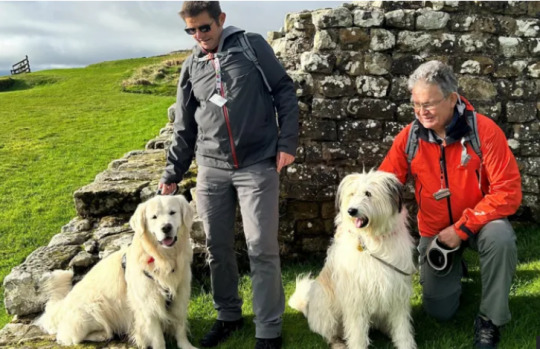
The best museum volunteers
Salvaging the historic tiles of California’s burned fireplaces
After devastating fires blazed through the region, residents are holding on to the intricate glazed tiles that survived — small but meaningful remnants of their homes.
Dublin's Molly Malone statue to get stewards to stop 'groping'
Stewards are to be stationed next to a statue of Molly Malone in Dublin to discourage people from touching it. Dublin City Council is running a pilot scheme for a week in May after complaints of people groping the sculpture's breasts.

Cute when it's a dog statue, weird and kind of gross when it's a woman
'I love my country': Ken Burns on showing the dark parts of US history
Ahead of his upcoming PBS documentary, The American Revolution, acclaimed film-maker Ken Burns tells BBC special correspondent Katty Kay about his unique approach to chronicling US history, from war and conflict to baseball and jazz.
In search of Greece's once-great Jewish city
Once home to a thriving Jewish majority, Thessaloniki holds fragments of a lost world. One traveller's journey to find them leads to something even more powerful: living memory.
Point:
Counterpoint:
Dinosaur tracks uncovered at site of Bonnie Prince Charlie’s refuge
When Bonnie Prince Charlie fled the Scottish Highlands after defeat at the Battle of Culloden, his route may have crossed the fossilised footsteps of massive meat-eating dinosaurs, researchers say.
Bonnie Prince Charlie being eaten by a theropod would be an incredible ending to Outlander
#heritage news of the week#museums#it's looking grim for us institutions#archaeology#history#more historic sites should have dog volunteers#also stop groping molly malone you weirdos#paleontology#the post is extra long this week
12 notes
·
View notes